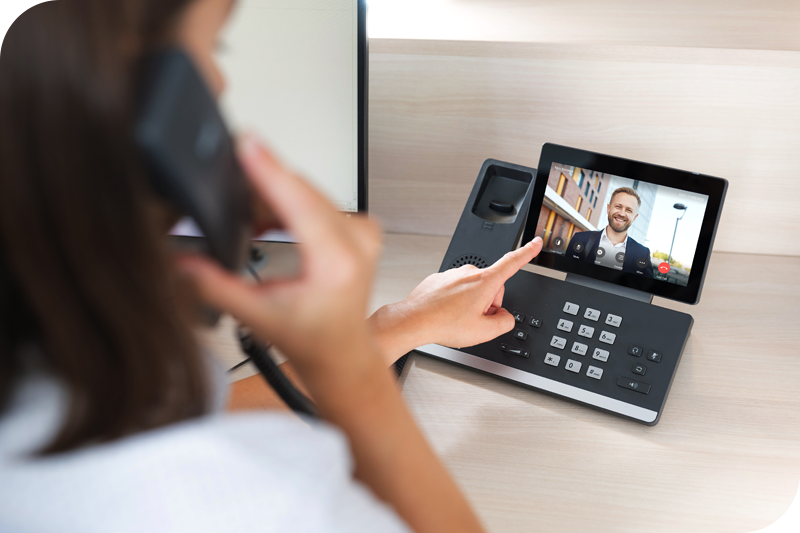From Indoor Stations to IP Phones – Exploring Modern Reception Call Management
 Camilla Ashdown, 29. 02. 2024 | 5 min read
Camilla Ashdown, 29. 02. 2024 | 5 min read
Which device is best for receptionists answering IP intercom calls, and which suits your needs? Explore our options: from indoor stations to smart desk phones

In fast-paced environments, receptionists play a crucial role in managing access by being responsible for IP intercom call management.
An IP intercom is an IP device installed at entrances and allows guests outside the building to communicate (via video and/or audio) with personnel inside, who will then grant or deny them access. Crucially, it controls access to the building – making it an important tool for site security.
How receptionists in offices or residential buildings receive calls from the IP intercom is perhaps as important as the intercom itself. Receptionists controlling access have diverse devices at their disposal to streamline and enhance intercom call management, from IP phones to actual hardware indoor stations. Let’s explore them!
Smart Desk Phones
Let’s start with what we view as the best option: smart desk phones, or IP video phones such as the 2N® IP Phone D7A. These devices are phones with screens that are directly connected to the IP intercom at the front entrance and can display video intercom footage on the screen when a call is incoming.
Smart desk phones are great because they often have user-friendly interfaces, touchscreens which display visitors clearly for better security, and programmable keys, allowing receptionists to respond to incoming calls quickly and easily. Integration capabilities with other communication systems further enhance their utility in a corporate setting. Plus, of course, they can be used as a regular phone for day-to-day communications.
The 2N® IP Phone D7A offers all this, boasts a 7’’ inch touchscreen, is equipped with Android OS for easy integration with third-party apps such as Zoom Phone and Skype, and only takes three minutes to set up! This, and devices like it, should be a key part of any modern reception.
Hardware Indoor Station on a Desk Stand
Another option is to install an indoor station, such as the 2N® Indoor View or 2N® Indoor Compact, on a desk stand. Indoor stations are usually small, meaning they can fit on a receptionist’s desk quite comfortably, are specifically designed for handling IP intercom calls with ease and reliability, and can often come with supplemental features that enhance building security significantly.
The 2N® Indoor View, for example, can be used for video surveillance whenever needed – both by streaming the feed from the IP video intercom, as well as from up to 16 IP cameras. All this is with absolute clarity on a durable 7’’ HD touchscreen.
A limitation of using an indoor station is the fact that it cannot be used to call anyone internally – however, in modern offices, mobile phones are commonly used for this purpose anyway. Another issue can be that they play audio out loud – which, although fine in quiet places, can prove difficult in busy, loud environments.
Via Integrations with Microsoft Teams, Zoom Phone, and Other Corporate Apps
Many businesses rely on collaboration platforms like Microsoft Teams, Zoom, and other corporate applications.
Integrating IP intercom call functionalities into these platforms streamlines communication processes. Receptionists can manage intercom calls seamlessly within the same interface they use for other tasks, promoting efficiency and reducing the need to switch between different applications.
2N IP intercoms can be integrated easily with a vast range of third-party applications – including Cisco, Zoom, Microsoft Teams (via CyberTwice), Webex, and more!
Regular IP Phones plus the 2N® IP Eye
Another option is a regular IP phone (i.e. an IP phone without video capability) integrated with the external office intercom, with the addition of software like the 2N® IP Eye installed on a desktop offers a bridge between conventional and modern communication.
2N® IP Eye is a free desktop app that is used for video intercom call management and is ideal for when projects are using an IP phone that isn’t video-capable.
When an incoming call is received from the IP intercom, a pop-up window on the PC will display the video feed in 2N® IP Eye (allowing for visual verification), and the integrated IP phone on the desk will also ring (allowing for communication). The receptionist then grants access within 2N® IP Eye – and actually, they don’t even need to answer the call if they don’t need to.
It can also serve as a surveillance application, displaying live video feeds simultaneously in one interface - providing a comprehensive view of activities outside the building. Users can switch between IP intercom cameras and IP cameras from third-party manufacturers that are installed in places where an intercom isn’t needed.
Software Phones or Softphones
Receptionists can also leverage software-based solutions to handle IP intercom calls. Softphones are not physical devices, but rather software that provides a ‘phone’ interface on the chosen device – whether mobile or desktop.
Receptionists can use these to answer calls as the software can be integrated with an IP intercom. However, as the software is just software (and not a hardware device designed for answering calls) they will need to use a headset and/or microphone to allow for audio capability. Additionally, softphones can require additional user training – which they would not need to navigate something as user-friendly as an indoor station or IP phone.
Should softphones be the choice for you, however, 2N IP intercoms can be integrated with a good range of them!
Receptionists today have a plethora of devices at their disposal to manage intercom calls efficiently. Whether they opt for smart desk phones, regular phones with additional software solutions, integrated corporate applications, or physical indoor stations, the key is to choose a solution that aligns with the specific needs of the company and/or building. By leveraging the right device, receptionists can improve communication and overall operational efficiency within the workplace.